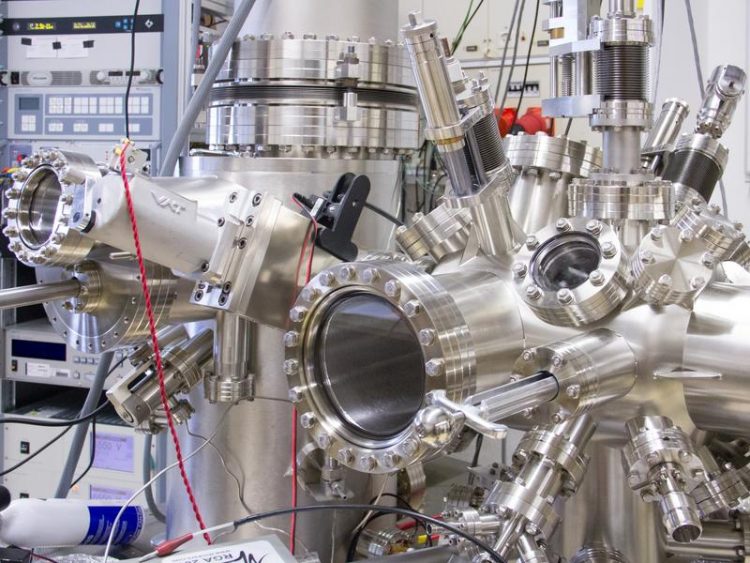Switching oxygen on and off

This is an atomic force microscope at TU Wien (Vienna). Credit: TU Wien
Oxygen atoms are highly reactive, yet the world does not spontaneously burn, even though everything is surrounded by this aggressive element. Why? The reason is that normal O2 molecules, are not particularly reactive.
At the Vienna University of Technology, it has now been possible to selectively switch individual oxygen molecules sitting on a titanium oxide surface between a non-reactive to a reactive state using a special force microscope. This process was viewed for the first time in high-resolution images.
Activation: Heat, or Electrons
“There are several ways to switch a stable, non-reactive O2 molecule into a reactive state,” explains Martin Setvin, a member of the research group of Prof. Ulrike Diebold at the Institute for Applied Physics at the Vienna University of Technology. “You can increase the temperature – that happens when you burn things. Alternatively, you can add an additional electron to the molecules, this also makes them chemically active.”
This process of activating oxygen molecules by adding electrons is ubiquitous — all living organisms use this trick, and modern fuel cells also work in this way. At the TU Wien, Setvin and coworkers are now able to activate individual O2 molecules at will using a force microscope, and learn how the process occurs at the atomic scale.
In the experiments, oxygen molecules were studied on the surface of a titanium oxide crystal at extremely low temperatures. Titanium oxide is a particularly interesting material used in many areas — from the coating for artificial hip joints to self-cleaning, dirt-repellent mirrors. It is also a photocatalyst, which means that it can induce chemical reactions when irradiated with light.
Seeing and Feeling Atoms
Key to the success of the oxygen experiments was a state-of-the-art atomic-force microscope, purchased by Prof. Diebold using proceeds of her 2014 Wittgensteinpreis Award. “A tiny needle is vibrated and moved across the surface. When the atoms at the very end of the tip come close to the surface, the tip feels a force and the oscillation changes. From this tiny change, one can create an image showing where the atoms are, “says Diebold.
“Essentially, the reactive oxygen molecules that have an extra electron exert a stronger force on the tip than the unreactive ones, and thus we can distinguish them.” Interestingly, it is also possible to inject an additional electron to an individual oxygen molecule with the same tip, and then observe the transition from the inactive to the active state. The same process also happens when the surface of the titanium oxide is irradiated with light — electrons are liberated inside the material, and can come to the surface to activate one of the oxygen molecules.
“Whether we add an electron using the microscope or by irradiating the titanium oxide — the end result is the same,” says Ulrike Diebold. “Our method gives us a whole new level of control over this process, and opens up new possibilities for investigating the inner workings of photocatalysts.”
###
Martin Setvin, PhD,
Institute of Applied Physics
TU Wien
Wiedner Hauptstraße 8-10, 1040 Wien
T: +43-1-58801-13458
martin.setvin@tuwien.ac.at
Prof. Gareth Parkinson
Institute of Applied Physics
TU Wien
Wiedner Hauptstraße 8-10, 1040 Wien
T: +43-1-58801-13473
gareth.parkinson@tuwien.ac.at
Media Contact
All latest news from the category: Physics and Astronomy
This area deals with the fundamental laws and building blocks of nature and how they interact, the properties and the behavior of matter, and research into space and time and their structures.
innovations-report provides in-depth reports and articles on subjects such as astrophysics, laser technologies, nuclear, quantum, particle and solid-state physics, nanotechnologies, planetary research and findings (Mars, Venus) and developments related to the Hubble Telescope.
Newest articles

Silicon Carbide Innovation Alliance to drive industrial-scale semiconductor work
Known for its ability to withstand extreme environments and high voltages, silicon carbide (SiC) is a semiconducting material made up of silicon and carbon atoms arranged into crystals that is…

New SPECT/CT technique shows impressive biomarker identification
…offers increased access for prostate cancer patients. A novel SPECT/CT acquisition method can accurately detect radiopharmaceutical biodistribution in a convenient manner for prostate cancer patients, opening the door for more…

How 3D printers can give robots a soft touch
Soft skin coverings and touch sensors have emerged as a promising feature for robots that are both safer and more intuitive for human interaction, but they are expensive and difficult…





















